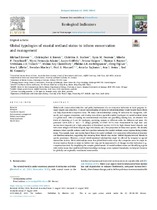Global typologies of coastal wetland status to inform conservation and management
Date
2021Author
Rajkaran, Anusha
Sievers, Michael
Brown, Christopher J.
Metadata
Show full item recordAbstract
Global-scale conservation initiatives and policy instruments rely on ecosystem indicators to track progress towards targets and objectives. A deeper understanding of indicator interrelationships would benefit these efforts and help characterize ecosystem status. We study interrelationships among 34 indicators for mangroves, saltmarsh, and seagrass ecosystems, and develop data-driven, spatially explicit typologies of coastal wetland status at a global scale. After accounting for environmental covariates and gap-filling missing data, we obtained two levels of clustering at 5 and 18 typologies, providing outputs at different scales for different end users. We generated 2,845 cells (1° (lat) × 1° (long)) globally, of which 29.7% were characterized by high land- and marine-based impacts and a high proportion of threatened species, 13.5% by high climate-based impacts, and 9.6% were refuges with lower impacts, high fish density and a low proportion of threatened species. We identify instances where specific actions could have positive outcomes for coastal wetlands across regions facing similar issues. For example, land- and marine-based threats to coastal wetlands were associated with ecological structure and function indicators, suggesting that reducing these threats may reduce habitat degradation and threats to species persistence. However, several interdimensional relationships might be affected by temporal or spatial mismatches in data. Weak relationships mean that global biodiversity maps that categorize areas by single indicators (such as threats or trends in habitat size) may not be representative of changes in other indicators (e.g., ecosystem function). By simplifying the complex global mosaic of coastal wetland status and identifying regions with similar issues that could benefit from knowledge exchange across national boundaries, we help set the scene for globally and regionally coordinated conservation.

